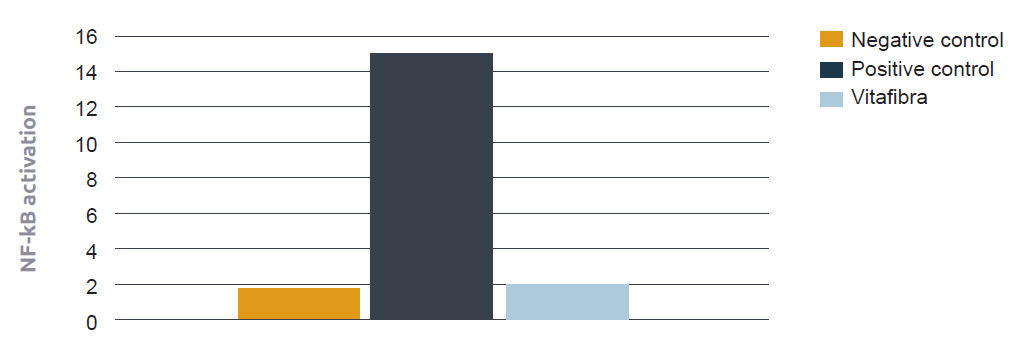By Maartje De Vos (product developer pigs) and Sofie Tanghe (product developer pigs)
Weaning is a stressful event in the life of piglets and often coincides with impaired gut health. Enterotoxigenic E.coli F4 is associated with post-weaning diarrhea in piglets. The initial step of an E.coli infection is to attach to host-specific receptors present on the enterocytes. In doing so, the immune response is initiated. To prevent attachment of E.coli to the gut wall and inhibit overstimulation of the immune receptors, the R&D team of the Royal Agrifirm Group has developed a health fiber, called Vitafibra.
Vitafibra works via two different pathways. First, the attachment of E.coli to the gut wall is impeded through agglutination. This means Vitafibra will bind to the fimbriae of pathogenic bacteria, making them unable to attach to the intestinal wall. Second, the receptors on the gut wall are blocked by Vitafibra, so the immune receptors are not overstimulated.
The dual mode of action by Vitafibra is shown in two in vitro tests. First, an in vitro test was performed to demonstrate the agglutination potential of Vitafibra on E.coli F4 utilizing a light microscope and image processing (Fig. 1).


Second, an in vitro test was performed to study the effect of Vitafibra on the prevention of overstimulation of the immune receptors, by actively blocking these receptors. To study the blocking capacity of Vitafibra, the HEK-BlueTM TLR cell-based assays were used (Invivogen, Toulouse, France). These HEK-BlueTM cells are known to express Soluble Embryonic Alkaline Phosphatase (SEAP) in response to stimulation of the TLR-specific agonist and activation of the NF-ĸB pathway. The expression of SEAP can then be quantified by measuring colorimetric changes after the addition of Quanti-blue.
HEK-BlueTM cells were cultured in DMEM culture media (Lonza, Basel, Switzerland) and seeded at 500,000 cells/ml in 96-well plates at 100 μl/well. Cells were allowed to grow overnight. The following day, inhibition of TLR was studied by pretreating HEK-Blue™ cells with Vitafibra (1 mg/ml) for 1 h, followed by treatment with LPS being a TLR agonist. Culture medium was included as a negative control, whereas LPS was included as a positive control. When the cells were exposed to LPS, these cells secreted SEAP. The activity of SEAP converts the pink QUANTI-Blue substrate to blue which could be quantified using an ELISA plate reader. The addition of Vitafibra resulted in a 10-fold decrease in the secretion of SEAP, meaning that Vitafibra resulted in less activation of the NF-ĸB pathway as compared to the positive control group without Vitafibra, and is thus an effective blocker of the immune receptor (Fig. 2).

Additionally, the mode of action of Vitafibra was studied in an in vivo piglet trial. Weaned piglets (n=10 per treatment) were fed a weaner diet with or without 2 kg/ton Vitafibra. On day 14, after weaning, small intestinal tissue was sampled to measure the attachment of E.coli to the intestinal wall. Also, to determine the amount of E.coli present, samples samples of the intestinal content were taken from the ileum, caecum and colon. Finally fecal samples were taken to measure myeloperoxidase (MPO), which is a specific marker of neutrophil activity, as an indicator for intestinal inflammation.
Beneficial effects of Vitafibra on the prevention of E.coli attachment to the gut wall were observed. Adding 2 kg/ton Vitafibra to the piglet diet decreased the attachment of E.coli on the small intestinal wall by 85%. Also, the E.coli presence in the intestinal content was decreased by adding Vitafibra to the diet. In the content of the ileum, caecum, and colon, a reduction in E.coli was observed at 89%, 94%, and 86% respectively (Fig. 3). These in vitro test results confirm Vitafibra does agglutinate with E.coli to prevent adhesion to the enterocytes, reduced adherence typically characterizes fewer replications of E.coli. Moreover, less presence of E.coli in the intestinal content will implicate less shedding by the piglets. Furthermore, the MPO concentration in the feces was decreased by 49%, indicating lower intestinal inflammation when Vitafibra was added to the piglet diet after weaning.

These beneficial effects on gut health were translated in better piglet performance and health. Adding Vitafibra to the weaner diet improved the feed conversion ratio by 17% and resulted in better fecal consistency. To conclude, Vitafibra reduces the risk of pathogen overgrowth by capturing E.coli bacteria and by blocking immune receptors, resulting in less inflammation and better piglet performance. This makes Vitafibra a successful part of the Aim for Zero 4 in 1 concept in the battle against E.coli diarrhea and supports the piglet in a smooth weaning transition.
Contact your agrimprove expert
Do you have a question or want personalized advice? Your Agrimprove expert is willing to help. Reach out directly or request to be contacted at your convenience.
